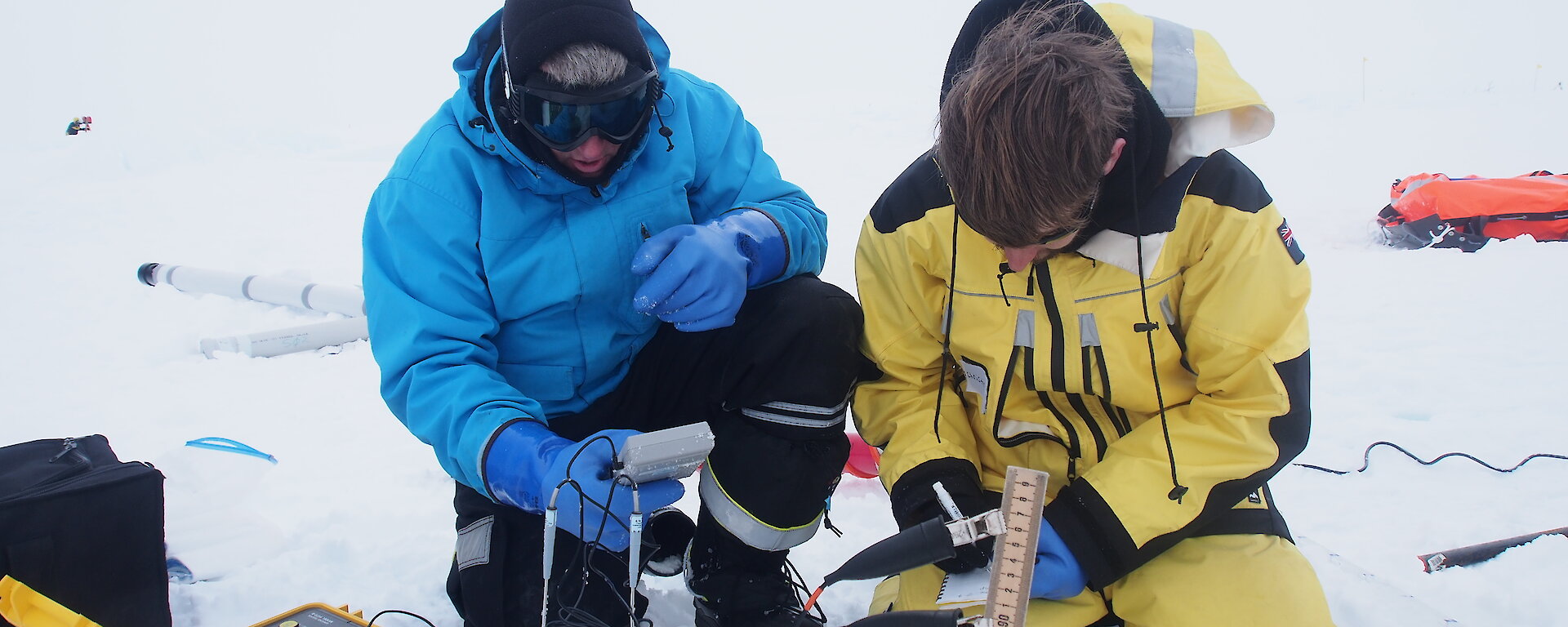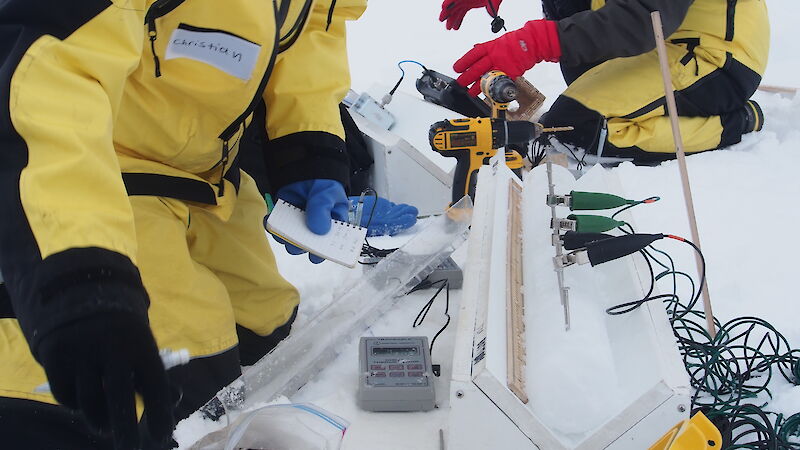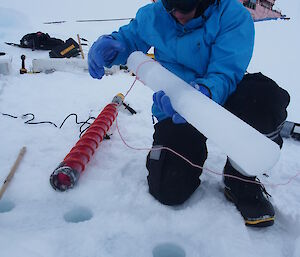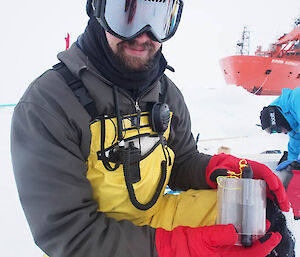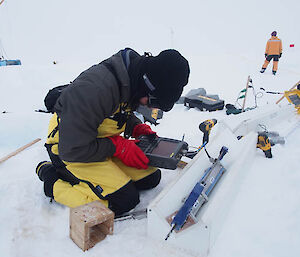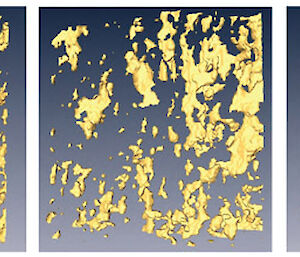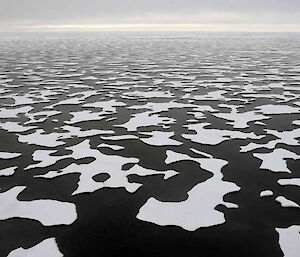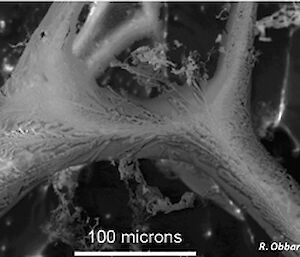Monday 29 October 2012
University of Utah mathematics professor, Ken Golden, vividly remembers the moment in 1994 when all the threads of his academic career came together in a pivotal realisation.
“I was out on the ice at midnight in the eastern Weddell Sea in a raging storm and I saw seawater suddenly percolate up and flood the surface,” he says.
“I’d just spent years of my life proving rigorous theorems about percolation models and I knew enough about the structure of brine inclusions in sea ice to realise that what I was seeing was a percolation threshold – a ‘tipping point’ in the connectedness of these inclusions.”
In that one moment Ken realised that when sea ice reaches a critical temperature, the pockets of brine connect up to form brine channels, shifting the ice from an impermeable state to a permeable one. When this happens, seawater underneath the ice can percolate upwards and flood the ice surface, where it combines with snow to form snow ice.
As sea ice warms, the volume of brine in the ice (the ‘brine volume fraction’) increases. Through analysis of the data from their 1994 expedition and previous work on brine drainage, Ken was able to deduce that the tipping point occurred at a brine volume fraction of about 5%. By coincidence, the threshold from impermeable to permeable ice occurs when the temperature is −5°C, for a typical bulk salinity of the ice of 5 parts per thousand. Ken went on to prove this hypothesis and coined the term the “rule of fives”.
The rule of fives applies to ‘columnar ice’ (the long, downward-growing ice crystals formed under calm conditions, described in a previous blog post), which comprises most of the ice in the Arctic and a significant proportion in the Antarctic. In the Arctic the permeability of sea ice is important in the formation and longevity of dark melt-water ponds on the surface of the ice, which absorb sunlight (and heat) and affect the ‘albedo’, or light reflecting properties (see last blog post), of the region.
“Sea ice albedo is one of the least understood parameters in the climate system in terms of modelling, and a significant source of uncertainty in climate projections” Ken says.
“Whether these Arctic melt ponds drain in a day or pool up and cover more of the ice is largely controlled by the rule of fives. So the brine microstructure of the ice and its fluid flow properties control larger scale processes that are critical for climate modelling.”
The rule of fives also affects the availability of nutrients for sea ice algae which, in Antarctica, provide an important food source for krill. Once the tipping point for changing permeable ice into impermeable ice reaches an algae layer, the algae are stuck with the nutrients they have and there can be a dramatic decrease in their growth rate.
“So biological activity often turns on and off according to the rule of fives,” Ken says.
Since his light-bulb moment, Ken has conducted numerous studies in the Arctic and Antarctic, including the previous Sea Ice Physics and Ecosystem eXperiment (SIPEX) in 2007, gathering data on the permeability of different ice types.
As well as columnar ice, Antarctic ice is comprised of about two thirds granular ice, which is more fine-grained than columnar ice. It forms in turbulent weather and sea conditions, and as snow ice. Back in 1998 Ken predicted that the more randomly distributed brine pockets in granular ice would exhibit a percolation threshold at a higher critical brine volume fraction than in columnar ice, making it harder for fluid to flow through the ice. In other words, the rule of fives would not apply. But perhaps another rule would.
He saw hints of this on SIPEX-I. Now, here on SIPEX-II, Ken and his PhD student Christian Sampson and electrical engineering graduate student David Lubbers, are putting all their experience, observations, theory, and high-tech (and low-tech) equipment together to look at the difference in permeability between columnar and granular ice.
To do this the team drill an ice core and measure temperatures along its length – the bottom of ice is warmer (and more permeable) than the top, because it’s close to the ocean. They then measure the electrical conductivity of the core (in the vertical direction), which relates to permeability. The higher the conductivity – the ability to move electrons from one end of the core to the other – the higher its permeability.
“It makes sense that conductivity and permeability are linked, because to have electricity flow through the core you need a path for the electrons to flow,” David says.
“The electrons will move through brine, which is salty and electrically conductive. But if the brine channels are isolated from each other, fluid can’t move through them and, similarly, the electrons can’t move through them because there’s solid ice in the way.”
The core is then cut into sections and measured for salinity, which provides the team with the brine volume fraction. The crystal structure of this core is also determined.
The team then drills several ‘partial permeability holes’ or ‘sack holes’ of different depths, near where their core was taken, to look at how quickly sea water percolates up through the bottom of the ice. The sides of the holes are packed tightly with plastic tubing collected from Ken’s hobby in construction and demolition, to provide a perfect seal against the horizontal movement of water.
“Then we deploy pressure sensors into the holes to see how, over time, the water level changes,” Ken says.
“If the ice is permeable then a lot of water will move in quickly; if not, then the water will take a long time.”
Finally, the team takes microwave measurements through a thin section of ice to see how the electromagnetic properties of the ice alter the returning microwave signal and whether it correlates with the rule of fives. These measurements will be combined with experiments by their colleagues from New Zealand and Alaska on ‘cross-borehole tomography,’ where electrode strings are frozen vertically into the ice and the effective electromagnetic properties of the ice between them are reconstructed mathematically. If it all works, it could be scaled up to collect information about the ice type, fluid movement and temperature, from buoys deployed on the ice or from satellites.
“Then we could electrically classify ice as impermeable enough to allow melt ponds in the Arctic to grow, or highly permeable ice that allows for carbon dioxide pumping and the build-up of sea ice algae,” Ken says.
This is Ken’s seventh trip to Antarctica and no doubt it won’t be his last. Already he is forging potential future collaborations with other scientists participating in SIPEX-II.
“Research evolves and advances when you’re around so many different people with diverse talents and backgrounds. Then you have the opportunity to try different methods and explore really new ideas,” he says.

